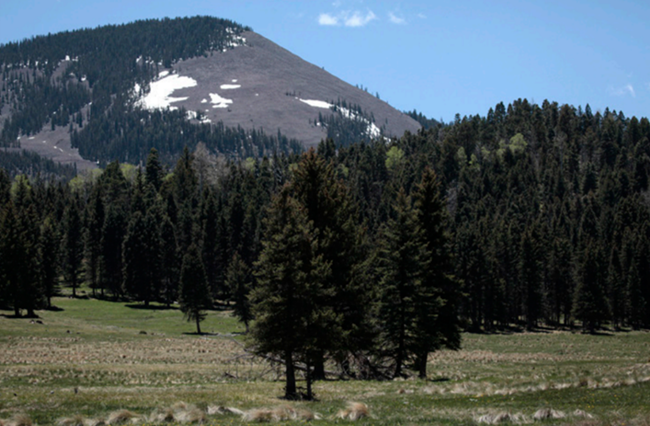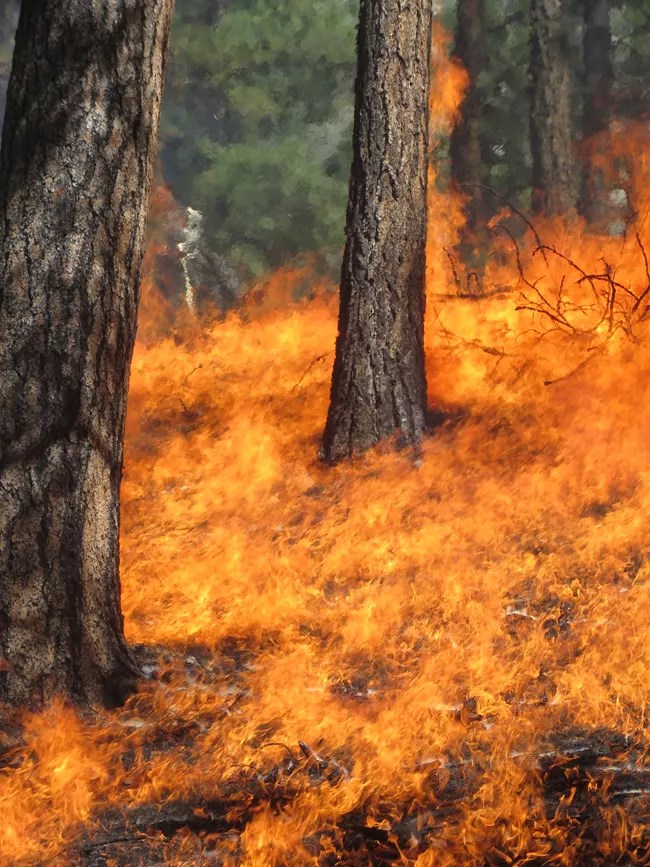
NPS/Sarah Hall Valles Caldera National Preserve's elevation range between 8,000 and 11,254 feet fosters a diversity of plant communities. This topographic mosaic of expansive valley meadows, lush forested volcanic domes, riparian wetlands, and old growth Ponderosa pine groves are in striking contrast to the arid New Mexico landscapes at lower elevations. Plant CommunitiesRiparian wetlands at Valles Caldera include the marshy meadows, fens, bogs, vernal pools, springs, and seeps that occur in the large, open, low-gradient landscape areas. About 8% of Valles Caldera's land area can be classified as wetlands. A variety of sedges (Carex spp.), cinquefoil (Potentilla spp.), rushes (Juncus and Eleocharis spp.), and longleaf pondweed (Potamogeton nodosis) comprise Valles Caldera's wet meadows. 
NPS/L. Ray Montane grasslands or meadows contain predominantly grass and grass-like species. Trees are usually absent or rare. However, montane grasslands are vulnerable to encroachment of trees due to changing climate, historic grazing practices, and the absence of low-severity and frequent fires. Montane grasslands will often burst with wildflowers during the warmer months when sunshine and rainfall are abundant. At Valles Caldera, the greatest variety of wildflowers can be found in July and August. 
NPS/L. Ray Montane forests of the American Southwest are generally divided into four forest types based on the dominant tree species. With increasing elevation, they include three coniferous forests: ponderosa pine forest, mixed conifer forest, and spruce-fir forest. The fourth forest type is quaking aspen forest, a deciduous forest that grows in areas of past disturbance, primarily at the elevation of mixed conifer forest. Valles Caldera National Preserve contains all four montane forest types with the following percentages of land area covered:
The mid-elevation mixed conifer forests occupy the largest area of Valles Caldera and include dry and moist mesic forests and woodlands, as well as blue spruce (Picea pungens) stands that occur along the fringes on north aspects of mountain slopes. The ponderosa pine (Pinus ponderosa) forests, which are between the mixed conifer forests and upper montane grasslands, occupy the forest zone’s lower elevations. 
NPS/R. Parmenter Felsenmeer rock fields are exposed rock outcrops or scree fields that make up only about 1% of Valles Caldera National Preserve's land area. A felsenmeer is a unique environment characterized more by rocks than by plants. Growing conditions for plants are harsh because the poorly developed soils don’t hold much water. This community provides some of the best habitat at Valles Caldera for the American pika (Ochotona princeps), a cute, but climate-sensitive, mammal. Species ChecklistSelect a Park:Select a Species Category (optional):
Search results will be displayed here.

Photo courtesy of USGS Fire EcologyNative plant communities across the Jemez Mountains have evolved alongside periodic fire for eons. Wildland fire can deter invasive species from taking hold and provide further ecosystem benefits like nutrient cycling, boosting soil fertility, stimulating new plant growth, promoting seed germination, and improving habitat for fire-adapted native species. However, as Anglo-European settlement burgeoned across North America in the 19th and 20th centuries, naturally-occurring fires were often suppressed to protect life and property. This altered native plant communities across the Jemez Mountains and beyond. |
Last updated: January 19, 2024
